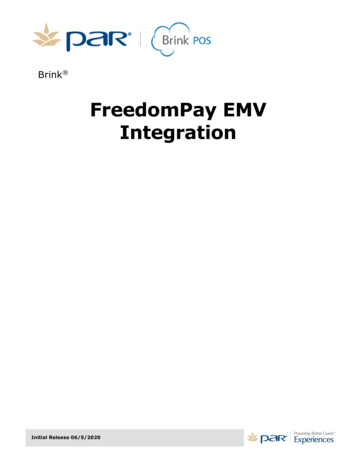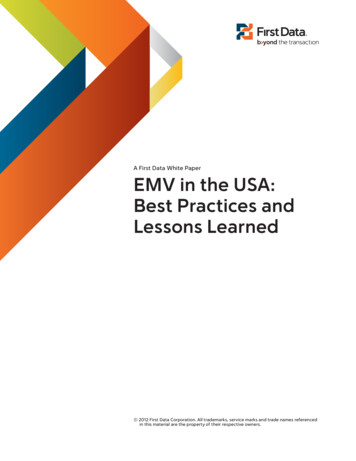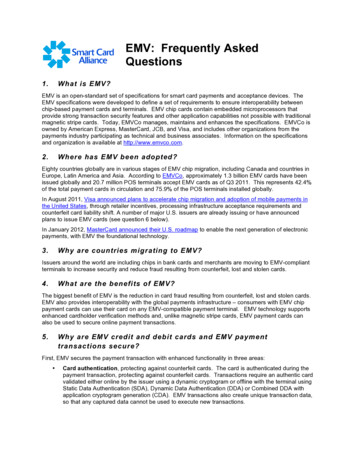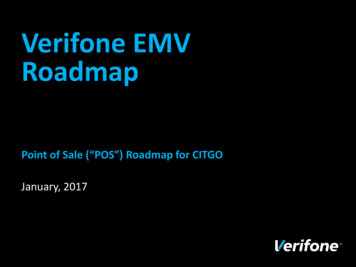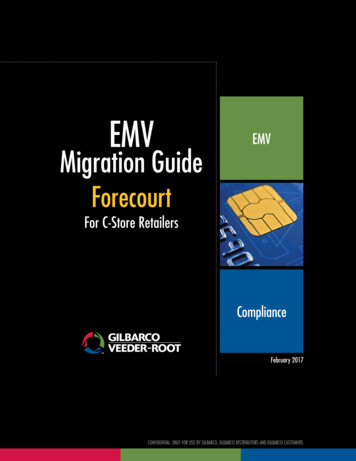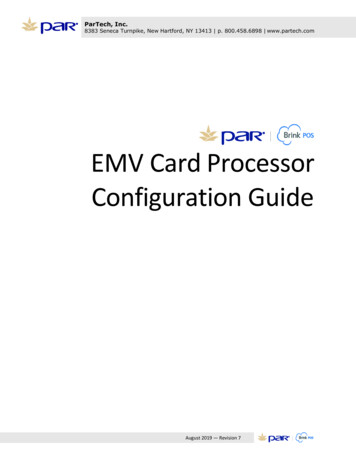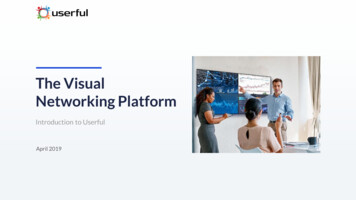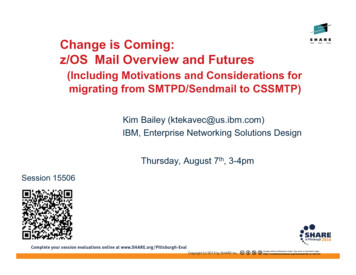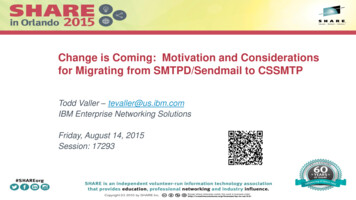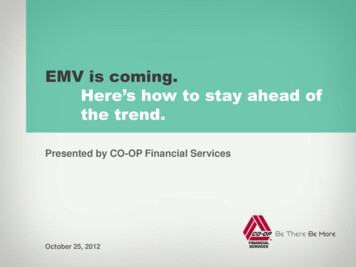
Transcription
EMV is coming.Here’s how to stay ahead ofthe trend.Presented by CO-OP Financial ServicesOctober 25, 2012
Agenda What EMV is and how it worksU.S. and global adoptionImpact to the payments ecosystemRecommendations for your credit unionLive Q & A
EMV Webinar Overview
EMV Webinar Overview EMV widely accepted abroad, coming to the U.S. U.S. Financial Institutions are assessing EMV deployment Questions such as:– What must we do?– What does the business case look like (i.e. how do we pay for it)?– When do we move forward? Myriad of issues with EMV deployment in the U.S. We want to help you evaluate this for your credit union
What is EMV and how does itwork?
What is EMV? The terms EMV and chip used interchangeably– EMV is the global specification which supports smart card/terminal/processing interoperability– It is an open, industry-wide specification, developed in 1994 byEuropay, MasterCard, and Visa– Maintained by EMVCo LLC, formed in April 1999– EMVCo LLC is owned by Amex, JCB, MasterCard and Visa EMV provides strong security features not possible withtraditional magnetic stripe cards
What is a chip card? A chip card has a magnetic stripe and a smallmicroprocessor embedded into it The chip contains an operating system and one or moreapplications This microprocessor and contact plate are mounted on thefront of the card The microchip is encrypted, which means that it is extremelydifficult to copy or counterfeit
How does it work? Chip cards are miniature computers with an operating system and multipleinterfaces and applications In an EMV scenario, a cardholder inserts an EMV card into the readerThe card and terminal enter into a dialogIssuer “preferences” for authorization and authentication on the chip takesprecedence over the terminal “preferences”
Cardholder Verification MethodsThe term “Chip and PIN” may be misleading. EMV supportsfour cardholder verification methods (CVMs)1. Online PIN, where the PIN is encrypted and verified online by theissuer (host)2. Offline PIN, where the PIN is verified offline by the chip on the card3. Signature verification, where the cardholder signature is comparedto the signature on the card4. No CVM (typically for low value transactions)ATMS are typically required to always support Online PIN
Cardholder Verification MethodsIssuer preference determines the CVM used, but the terminalmust have a matching CVM choiceCard’sCVM ListTerminal’sSupported CVMsOffline PINOnline PINSignatureOnline PINNo CVMSignatureNo CVM
Online versus OfflineOffline means the terminal communicates with the chip embedded in the cardversus the hostOnline PIN, online authorization The terminal transmits the encrypted PIN (if applicable) and payment information tothe host for authorization similar to the magnetic stripe process today.Offline PIN, online authorization PIN is validated offline, and the result is sent in the message with the payment datafor online authorizationOffline PIN, offline authorization PIN and transaction are verified and authorized offlineCard is synced with host the next time it goes onlineTypically only unattended terminals
U.S. and Global Adoption
Global Adoption EMV initially adopted to combat fraud in areas where offlineauthorization was the norm France, the first country to deploy EMV, experienced 80%decline in counterfeit fraud activity 1.5 Billion cards issued globally by Q4 2011 18.7 million POS devices Online authorization becoming more prevalent Offline authorization is still used in some unattendedterminals
Global Adoption by Region
Canadian Fraud Statistics (EMV deployment began in 2009)Interac Association announced that Interac debit card fraud losses to financial institutions resultingfrom skimming declined again in 2011 "Our collective efforts and significant investments in the fightagainst debit card fraud, particularly the transition to chip technology, are producing tangiblebenefits," said Caroline Hubberstey, Head of External Affairs, Interac Association. Toronto 3/16/2012Dollars Lost to Debit Card Fraud 160 142 140 119In Millions 120 107 95 100 80 105 70 70 60 40 20 0200520062007Interac is the PIN debit network in Canada2008Year200920102011CO-OP estimatesthat approximately50% of fraud isdue to counterfeitcards created fromskimming.
U.S. Response U.S. is behind the rest of the world in deploying EMV Actions by U.S. Networks (V/MC/Amex/Discover) drivingadoption EMV efforts consuming existing payment eco-system for thenext two to three years– Impact is to entire payments infrastructure– Acquirers frantically trying to meet 2013 merchant acquirer dates– EMV specifications do not support Durbin merchant routing controlcausing uncertainty for debit networks and deployment strategies There are no mandates for issuers and acquirers, only liabilityshifts starting in 2015
Visa EMV Timelines October 1, 2012: Merchants will be exempt from PCI reporting ifthey process 75% of their VISA transactions on EMV enabledterminals April 13, 2013: Merchant Acquirer processors must certify supportfor and accept Visa EMV chip contact and contactless transactions October 1, 2015: Liability Shift for counterfeit POS fraud will beassessed to the party that did not enable the chip-to-chip (EMV)transaction October 1, 2017: Same as above but for automated fuel dispensersMasterCard, American Express and Discover soon followed Visa with thesame timelines, eliminating some uncertainty in the market
Additional MasterCard AnnouncementsMasterCard has announced the following liability shifts April 19, 2013: Liability shift for inter-regional (cross border) ATMMaestro transactions at U.S. ATMs– ATM Acquirers will assume counterfeit fraud-related liability if a non-U.S issuedEMV card is used at a non EMV enabled ATM.Does not apply to US issued cards accepted at US ATMsRecently announced: October 2016: Liability shift will apply to all MasterCard-brandedproducts across all transactions initiated at U.S. ATMsVisa has made no announcements on ATMs
U.S. Adoption Limited adoption to date– Few issuers, primarily to international travelers– Few to no ATMs ready– POS terminals deployed, but software to enable an EMVpayment rare First credit union to deploy EMV cards:– United Nations Federal Credit Union (UNFCU)– Rollout went to 8,000 credit card accounts in a frequent flyercard program– Now roughly 40,000 EMV credit cards Industry experts expect conversion to EMV to take 10 years
Impact to Ecosystem
EMV Payment Applications An EMV payment application is the software thatdetermines the actions of the card and transaction EMV payment applications are network specific– Today only the four national networks have applications– Visa (VSDC), MasterCard (M/Chip), Discover (D-PAS) andAmerican Express (AEIPS) each have their own application The terminal and card must have the same applicationloaded– For example, a Visa EMV card used at a terminal loaded onlywith the MasterCard application will terminate or revert to magstripe
Hardware and Software Cards and terminals must have new hardware and newsoftware Many newer terminals have the hardware but not thesoftware The terminal can be loaded with multiple applications The card (chip) can also be loaded with multipleapplications Processors and other providers must code for hardwareand software
Payment Infrastructure Impacts All stakeholders in the payment chain are impacted Development needed by:–––––––Terminal manufacturers (both POS and ATM)MerchantsMerchant AcquirersEFT ProcessorsCore Data ProcessorsCard ManufacturersCard Personalization Bureaus Must code to every payment application to mimictoday’s interoperability Numerous opportunities for failure of cross-industryalignment
Deployment in the U.S.U.S. market is different than other parts of the globe: Competitive– Multiple PIN debit networks in addition to four national networks Online all the time– Significant fraud reduction will be years away New federal legislation– Durbin impact Other areas of the world:– One national PIN debit network– Offline/batch processing– Interoperability driven through regulation
Durbin Impact and Lack of Portability EMV deployment in the U.S. supports either one applicationon the card– Routing is to that specific network based on the application on the chip– Currently no support for direct routing to other networks, such as COOP, NYCE, or others Durbin compliance for merchant routing control and twounaffiliated networks is not supported Portability between networks without reissuance is notsupported
Finding a Solution CO-OP participation in industry working groups Regulators showing interest in insuring compliance One potential solution is for PIN debit networks to arrive at acommon solution or application––––Could have multiple AID’s to identify each networkProtects routing to the PIN debit networksIssuers have portability without reissuingMerchants, terminal manufacturers, card producers would have lessdevelopment Other solutions also being evaluated. Announcementsexpected soon.
Recommendations
Early Adoption There is no mandate for issuers or acquirers– Liability shift for acquirers in 2013 for Maestro internationaltransactions only (2016 for U.S. transactions)– Liability shift for issuers in 2015 shifts fraud liability to the partythat did not enable the EMV transaction Uncertain when we will reach critical mass of merchantterminals– EMV enabled terminals virtually non-existent in U.S. today High premium for early adopters of new technologies– Higher cost– Higher risk of deployment issues
Be Clear About Reasons to Move ForwardThe critical question for credit unions is “what is my reasonto implement now?” The answer to this question should lead to detailedanalysis– Evaluate benefits using data of existing portfolio– Include all costs– Consider all hidden factors, such as: Marketing strategyCardholder acquisitionCardholder retentionStaff trainingMember education
Fraud Reduction EMV will definitely reduce fraud losses—eventually Before moving forward today for this reason––––Analyze your fraud todayEMV will reduce fraud from counterfeit cardsEvaluate fraud impact in the near termEMV does not impact card-not-present fraud or lost/stolen fraud Equation will change once terminals are deployed inU.S.
Global Interoperability Industry estimates there are 5% of chip only terminalsworldwide International travelers are experiencing some issues withmagnetic stripe cards Determine the need Consider an EMV travel card Until your credit union has an EMV card, advise travelers:– Worldwide acceptance rules– Unmanned terminal strategies
Building the Business Case Accurately assessing costs is critical to determine timingMigration costs remain highCard cost has come down, but certification costs highEstimates of migration today– 25,000 – 60,0000 and up Card manufacturer and card personalization bureauNetwork (Visa/MC)Processor (EFT and Core)Marketing and implementation costs Consider all variables
Financial Impact of Uncertainty Routing issue resolution may be another application,potentially a “PIN debit” application Solves for routing and portability among networks Must be added at the time of the card issuance and terminaldeployment Issuing now could require reissuance of all EMV cards We advise you not to rush to issue of EMV cards until thisissue is resolved Upgrading ATMs now would require additional softwareupgrades later
CO-OP Support and Roadmap CO-OP technical support:– Beta testing EMV with a Visa issuer, live in November– Beta testing EMV with a MasterCard issuer early 2013– Beta testing EMV at the ATM with the MasterCard application,live in January 2013 Technical Roadmap– Online support including DE 55 (new data element specific toEMV): 2013– Offline support: 2014 Leadership– Active participation in EMV industry groups, such as the SRPc– EMV Resource Center: www.co-opfs.org/EMV
Summary EMV is a complex technology Complex deployment in the U.S. still to be resolved Most credit unions taking a wait and see approach, whichCO-OP recommends as well Become and stay informed Visit the CO-OP EMV Resource Center for up to dateinformation–––––White PapersBlogsAsk the ExpertWebinarsLinks to other resources
Questions?More resources are available at theCO-OP EMV Resource Center:www.co-opfs.org/EMV
First credit union to deploy EMV cards: –United Nations Federal Credit Union (UNFCU) –Rollout went to 8,000 credit card accounts in a frequent flyer card program –Now roughly 40,000 EMV credit cards Indus
